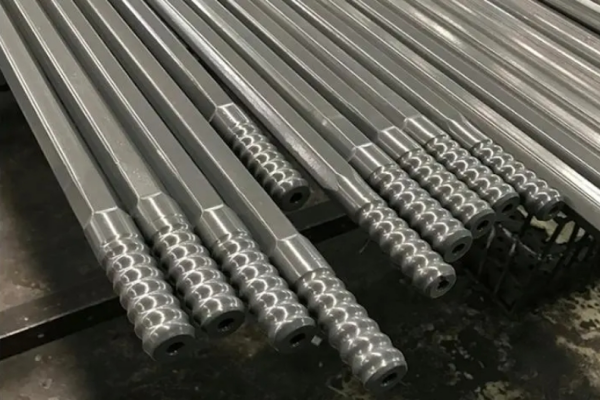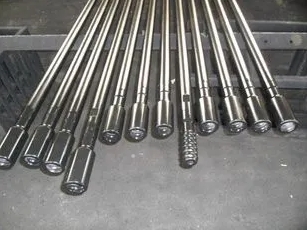What are the common causes and solutions for extension drilling rod joint breakage?
At present, as the torque of the drilling rig gradually becomes larger, the thread strength of the extension rod has been highly tested, so drill pipe joint fractures often occur during drilling operations, most of which are large-diameter drill pipes, and the fracture occurs at the male joint. Center end and threaded base. From the analysis point of view, first of all, the design of the extension rod thread cannot correctly match the design torque of the drilling rig. The underground industrial and mining environment is harsh and there are many coal and rock combination strata. During the process of deep hole drilling, the threads of harder rock layers also bear shear force when they bear torque, and the threads are easily damaged; secondly, the drill pipe is analyzed from a mechanical perspective. The position of the 1-2 buckles at the root end of the external thread is a contact position with great stress. When the fatigue limit of the drill pipe is exceeded, this is a risk point at the fracture location and it is easy to form a root brittle fracture.

The solution to the above problem is as follows:
1. Nitriding of male connector;
2. The thread is designed as a double-head structure;
3. In the case of the same diameter, a product with a larger buckle type should be selected.
How to buy hand extension rod?
1. Understand the characteristics of drill pipe. The extension rod is a drilling tool that uses an alloy steel pipe to thicken both ends of the upsetting head, turn a small pitch taper thread, and connect it to a locking joint. It is used in the field of geological exploration to transmit drilling torque to the bottom hole drill bit and is responsible for transmitting drilling fluid. Commonly used connection methods include male and female connections (tapered threads) and joint connections (rectangular internal threads).
2. Understand the extension rod material. At present, the national standard materials include DZ40, DZ50, DZ60, R780, etc. Among them, R780 is very good and has outstanding performance in toughness and wear resistance.
The body of the trolley-type drill pipe produced by Gaea Rock is made of geological-specific alloy steel pipes (R780, DZ50). The extension rod drill bit is made of alloy structural steel (42CrMo). After rough machining, vacuum tempering heat treatment is performed. Surface nitriding treatment after finishing can effectively solve the problems of gluing and stretching, and is more wear-resistant and easy to disassemble, greatly improving fatigue strength and shear strength.
3. According to the drilling capacity parameters, drilling diameter and drilling depth of the drilling rig, the diameter of the drill pipe is determined through the empirical ratio of D/D=4.5.
4. Select the drill pipe according to the main parameters of drill pipe design, namely torque and feed pressure. As we all know, the torque of the drill pipe is transmitted through the engagement and extrusion of the key and keyway. Due to machining accuracy, material properties, welding process and other reasons, it is impossible to evenly distribute torque on each key, and each contact key cannot have uniform contact force, so long keys often partially break. When selecting the design torque of the drill pipe, it needs to be greater than the design torque of the drilling rig.
5. Understand the processing process of drill pipe. In addition to good materials, case hardening is also important to ensure good wear resistance of the extension rod. Standard machining of threaded parts ensures that joints can be loosened frequently without damage. The extension rod has the characteristics of high bending strength and strong welding, which can ensure the straightness requirements of deep hole drilling and has a long service life.





